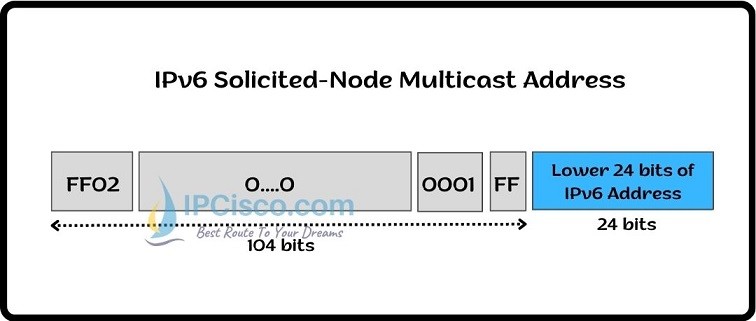- COURSES
- SPECIALS
- BLOG
- MEMBERS
- SHOP
- ABOUT
- ENROLL HERE

In IPv6 World, there is a specific IPv6 Multicast address named IPv6 Solicited-Node Multicast Address. Here, for every multicast address of a host, it must also join a Solicited-Node Multicast Group. This is done for layer 2 address discovery. Here, IPv6 Solicited-Node Addresses are used by IPv6 Neighbor Discovery Protocol (IPv6 NDP) to discover neighbors.
The first 104 bits of IPv6 Solicited-Node Multicast Address are fixed. This fixed part is FF02:0:0:0:0:1:FF00::/104. The remaining 24 bits of this addresses is copied from the IPv6 Link-Local address. In other words, it takes the low order 24 bits of IPv6 address and appends these bits to fixed FF02:0:0:0:0:1:FF00::/104 prefix.
Let ’s analyze these bits detailly. The first two octets (FF) show that it is an IPv6 multicast address. The second two octets (02) show that it is a Link-Local scope address. This means that, this multicast will stay in the network, it will not across this network. The next part is the part that will show us the exact IPv6 Solicited-Node Multicast Address part. It is ::1:FF. The latest 24 bits will be determined by Host ID.
You can also learn the other IPv6 Addresss Types on IPCisco.
We have IPv6 Multicast Addresses. So, why do we need another multicast address named IPv6 Solicited-Node Multicast Address. Let ‘s explain this by comparing with the IPv6 ARP mechanism. In IPv4, if one device wants to send a packet to a device and if it only knows its IP address, it needs to learn its MAC address. To learn this MAC address, it sends a broadcast message to the network which is received by all the nodes in the network. Here, only one device is needed, but all the other devices receive this packet, opened it and check if it is for it or not. The process is done through different layers of networking. This is a little inefficient mechanism and it is using ARP. In IPv6, there is no ARP and there is no layer 2 broadcast. But there is a mechanism to overcome it. It is IPv6 Solicited-Node Multicast Addresses.
With IPv6 Solicited-Node Addresses, there is no need for upper layers. Here, according to IPv6 Solicited-Node Multicast Address, any device can understand that it is for it or not. Again, all the devices receive the packet, but this time they do not need to open this packet. Because, this packet is not for them. They understand this from the IPv6 Solicited-Node Multicast Address.
You Can Also Learn Complete IPv4 Multicast Blocks!
You Can Also View Full IPv6 Course Lessons!
Leave a Reply